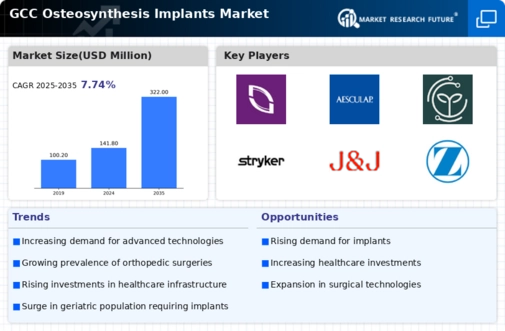Enhanced Regulatory Framework
The regulatory framework governing medical devices in the GCC is evolving, which is positively impacting the osteosynthesis implants market. Regulatory bodies are streamlining approval processes for new implants and technologies, thereby facilitating quicker market entry. This enhanced framework is expected to encourage innovation and attract investments in the osteosynthesis sector. As a result, manufacturers are likely to introduce a wider range of products that meet the specific needs of healthcare providers and patients. The osteosynthesis implants market is poised for growth as these regulatory changes foster a more conducive environment for the development and distribution of advanced orthopedic solutions.
Rising Incidence of Bone Fractures
The osteosynthesis implants market is experiencing growth due to the rising incidence of bone fractures in the GCC region. Factors such as an aging population, increased participation in sports, and road traffic accidents contribute to this trend. According to recent data, the incidence of fractures is projected to rise by approximately 15% over the next five years. This increase necessitates the use of osteosynthesis implants for effective treatment and recovery. As healthcare providers seek to improve patient outcomes, the demand for advanced osteosynthesis solutions is likely to escalate, thereby driving market growth. The osteosynthesis implants market must adapt to these changing dynamics to meet the needs of healthcare systems and patients alike.
Advancements in Surgical Techniques
Innovations in surgical techniques are significantly impacting the osteosynthesis implants market. Minimally invasive procedures, which reduce recovery time and improve patient outcomes, are becoming more prevalent in the GCC. The adoption of advanced imaging technologies and robotic-assisted surgeries enhances precision in implant placement. As a result, hospitals and surgical centers are increasingly investing in these technologies, which is expected to boost the market. The osteosynthesis implants market is likely to benefit from these advancements, as they not only improve surgical efficiency but also reduce complications associated with traditional methods. This trend suggests a promising future for the market as healthcare providers strive for excellence in patient care.
Increasing Awareness of Orthopedic Health
There is a growing awareness of orthopedic health among the population in the GCC, which is driving the osteosynthesis implants market. Educational campaigns and community health initiatives are informing individuals about the importance of bone health and the available treatment options for fractures and other orthopedic conditions. This heightened awareness is likely to lead to an increase in consultations with orthopedic specialists, resulting in a higher demand for surgical interventions. The osteosynthesis implants market must capitalize on this trend by providing comprehensive information and innovative solutions to meet the needs of an informed patient base.
Growing Investment in Healthcare Infrastructure
The GCC region is witnessing substantial investment in healthcare infrastructure, which is positively influencing the osteosynthesis implants market. Governments are prioritizing healthcare development, leading to the establishment of advanced medical facilities and specialized orthopedic centers. This investment is projected to increase by around 20% over the next few years, facilitating access to state-of-the-art medical technologies. As healthcare facilities expand, the demand for osteosynthesis implants is expected to rise correspondingly. The osteosynthesis implants market stands to gain from this trend, as improved infrastructure enables better patient care and enhances the overall healthcare landscape in the region.

















Leave a Comment